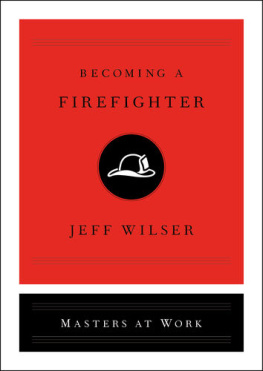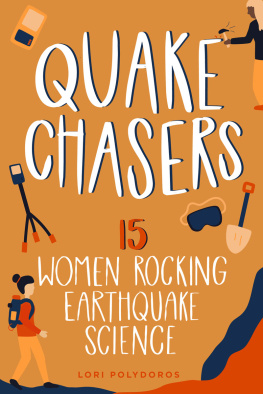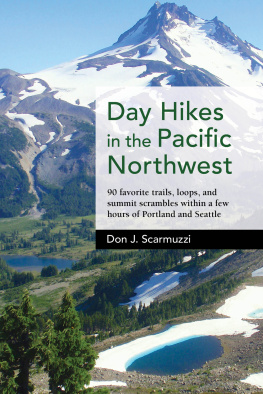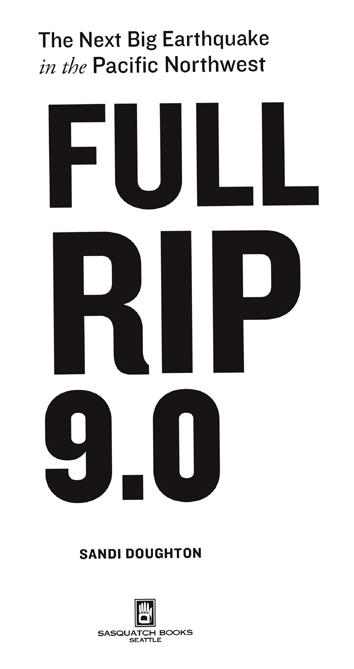Copyright 2013 by Sandi Doughton
All rights reserved. No portion of this book may be reproduced or utilized in any form, or by any electronic, mechanical, or other means, without the prior written permission of the publisher.
Published by Sasquatch Books
Editor: Gary Luke
Project editor: Michelle Hope Anderson
Cover design: Anna Goldstein
Interior design and composition: Sarah Plein
Cover photograph: Seattle Skyline Newleaf/Veer.com
Glass Smit/Veer.com
Copy editor: Sue Mann
Library of Congress Cataloging-in-Publication Data is available.
eISBN: 978-1-57061-855-0
Sasquatch Books
1904 Third Avenue, Suite 710
Seattle, WA 98101
(206) 467-4300
www.sasquatchbooks.com
v3.1
To my family of friends: RB, CB, PB, CD, BH, JJ,
MM, DM, DR, AS, SS, JV, Patu & Six-Thirty
CONTENTS
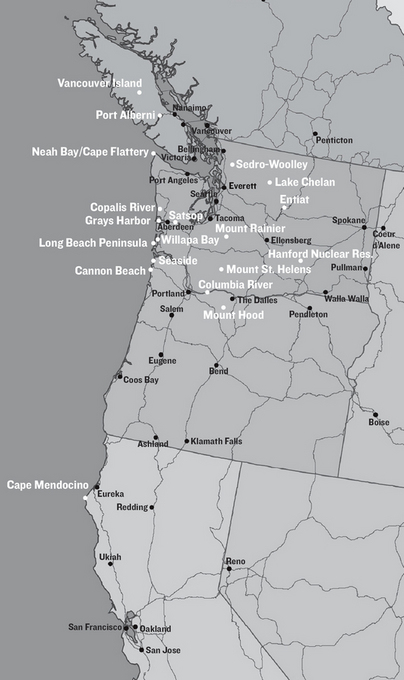
()
INTRODUCTION:
A WARNING FROM THE PAST
STORIES PASSED DOWN FROM THAT NIGHT dont tell us if dogs howled a warning. Huddled together in the cold, the animals might have sensed the first faint vibrations while the people slept.
A quarter moon hung in the sky.
Far offshore, where only the boldest whalers paddled their canoes, a seven-hundred-mile-long gash on the ocean floor was shifting. Masses of rock thrust past each other, grinding and buckling and jerking as if the planet were being torn apart.
People jolted awake in their longhouses. The motion pounded out a staccato rhythm, like a woodpecker hammering a tree. Cedar planks rattled and timbers groaned. In those first moments, it might have seemed as if a gale were sweeping in off the Pacific. But how could the wind rock the ground? Children cried out in fear. Men and women stumbled toward doorways.
The ground began to roll like the sea. People dropped to their hands and knees, felled by shaking so intense, cedar-bark baskets flew into the air. Ancient spruce trees whipped back and forth like saplings, raining branches onto the forest floor. The people lucky enough to make it outside clung in darkness to a world that seemed intent on casting them off.
As the seam in the seafloor continued to rip, the shaking swept along the western edge of North America. Under its thick blanket of mud, the margin of a great geologic plate shuddered and slid westward, pulling the continent with it. Shock waves raced out in all directions, traveling miles in seconds and rattling the shores of the inland sea many coast-dwellers had heard of, and some had visited. The people who live there today call it Puget Sound.
One minute passed.
Hillsides where condominiums now command million-dollar views trembled and sloughed off cascades of mud and stones. Deer and elk stampeded blindly, but couldnt escape the unearthly shaking. Nor could the people. From the Haida in the far north, to the Quileute on the Washington coast and the Yurok of Californias redwood forests, the tribes of the Pacific Northwest felt the earth reshaping itself beneath their feet.
Two minutes.
Carved posts that had supported plank buildings for generations crashed to the ground. It was January and the people were gathered in lowland camps for the winter. The river mouths where many longhouses clustered were the first to turn to jelly and spout geysers of watery sand. At the confluence where Portland would later spring up, sandbars vibrated into a slurry. Fountains spurted from spruce swamps along the Columbia River. The tide flats of the Duwamish River, today the busy port of Seattle, trembled and split. In the night, no one saw the undulations. Only later would people notice strange patterns left behind in the sand and silt.
Three minutes.
Forested slopes gave way, rushing downhill in a tumult. River valleys and shorelines quivered and dropped by several feet. Stands of cedar that had sprouted centuries ago were suddenly below sea level. Some of the gray-haired elders had felt the earth shake before; this time they wondered if it would ever stop.
The year was 1700.
When earthquakes strike urban areas, they give off a dull roar like a jet passing overhead. The din rises from thousands of structures vibrating and grating against each other. What would the sound have been like centuries ago, when there was just the thrashing of forests and the wrenching of miles-thick chunks of crust?
Four minutes.
The only signs of humanity were scattered native settlements. Imagine the scene today. What highway would remain passable after being tossed like a ship on the high seas? How many bridges and office towers could twist for four minutes and still stand? Pipelines that carry water, gasoline, and oil to fuel a modern economy run through the same valleys that dissolved under the shaking so long ago. Power poles march over slopes that were scarred by landslides and littered with fallen trees.
Five minutes.
Like a storm with its strength spent, the maelstrom in the earth subsided. The edge of the underwater plate ground to a halt, perhaps fifty feet from where it started. Along seven hundred miles of wild coastline, tribal communities who had never encountered each other rode out the final throes in tandem. In the stillness that followed, survivors must have felt as if they had slipped the clutches of an angry god. They couldnt have known the most awful blow was yet to come.
Triggered by the upheaval on the ocean floor, swells were hurtling toward the coast faster than any fish could swim. Would the sliver of moon have cast enough light to reveal the sea pulling back? Surely people heard the thunder as the surge neared shore and gathered height.
The ocean stampeded across the land like a tide gone mad. No longhouse could stand up to the rush. Beaches where hundreds of thousands of tourists now fly kites and race three-wheelers on sunny days were swallowed by waves no man or beast could outrun. Uprooted trees became battering rams. Caught up in the icy water, people flailed desperately for anything to grab onto, anything to keep them afloat. Entire villages were swept away in a matter of moments.
The earthquake that lashed the Pacific Northwest in 1700 ranks among the mightiest the Earth can yield. Scientists today call it a megaquakea magnitude 9 monster that ripped the full length of the offshore fault where seafloor and continent collide, and unleashed a killer tsunami. Only a handful of seismic disasters in modern times have approached the same level of fury.
No one who saw the videos from the 2004 Indian Ocean megaquake and tsunami will ever forget the wall of water that pulverized cities and muscled through resorts as if they were made of cardboard. More than two-hundred thousand people died. The force of the fault rupture made the Earth wobble on its axis.


